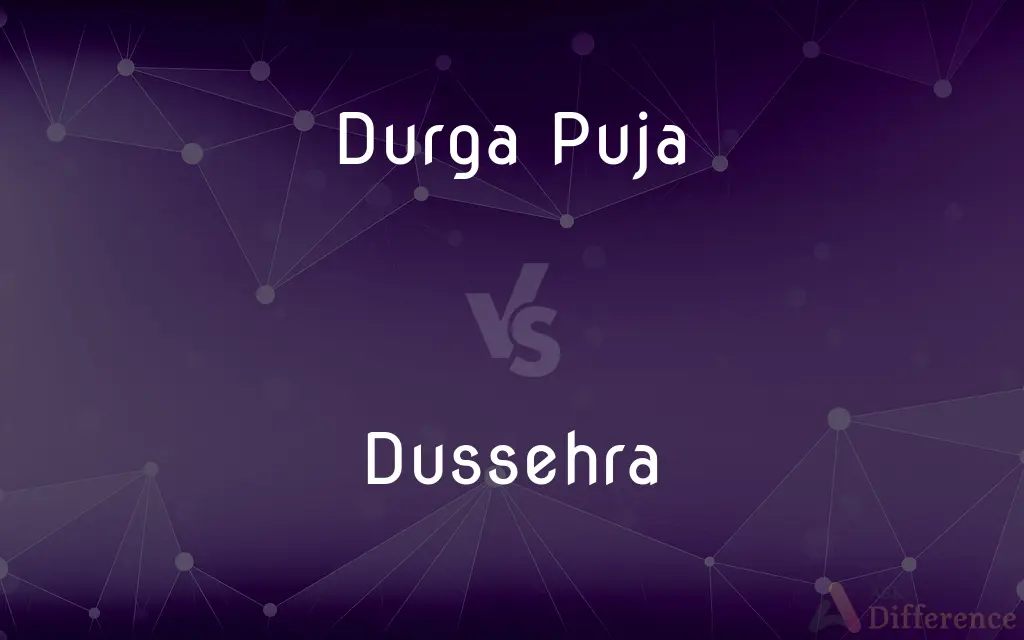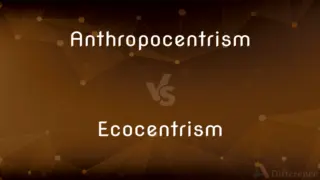Durga Puja vs. Dussehra — What's the Difference?
By Tayyaba Rehman & Urooj Arif — Published on February 9, 2024
Durga Puja is a Hindu festival celebrating Goddess Durga's victory over the buffalo demon Mahishasura. Dussehra marks Lord Rama's victory over Ravana, symbolizing the triumph of good over evil.

Difference Between Durga Puja and Dussehra
Table of Contents
ADVERTISEMENT
Key Differences
Durga Puja is a major Hindu festival primarily celebrated in Eastern India, honoring Goddess Durga's victory over the demon Mahishasura. It signifies the triumph of good over evil and the power of feminine strength. Dussehra, also known as Vijayadashami, is celebrated at the end of Navratri, marking Lord Rama's victory over the demon king Ravana. This festival is observed all over India and symbolizes the victory of good over evil.
Durga Puja involves elaborate rituals, idol worship, and cultural performances. It's a time for community gatherings, feasts, and artistic decorations, with pandals (temporary structures) set up to house the idols of Goddess Durga. Dussehra, on the other hand, is famous for its dramatic reenactments of the Ramayana, known as Ramlila, and the burning of effigies of Ravana, signifying the destruction of evil.
The celebration of Durga Puja spans over five days, known as Shashti, Saptami, Ashtami, Navami, and Dashami, each with its own rituals and significance. Dussehra is primarily observed on the tenth day after Navratri, with processions and fairs, and is considered an auspicious time for starting new ventures.
In Durga Puja, the immersion of Durga idols in water bodies marks the conclusion of the festival, symbolizing the goddess's return to her celestial abode. Dussehra is often associated with the practice of burning Ravana effigies, symbolizing the eradication of evil and the restoration of Dharma (righteousness).
Cultural aspects of Durga Puja include traditional dance, music, and the wearing of new clothes, reflecting joy and festivity. Dussehra, while also festive, has a strong emphasis on moral and ethical teachings from the Ramayana, with many people also involving in charitable acts and community service.
ADVERTISEMENT
Comparison Chart
Deity Celebrated
Goddess Durga
Lord Rama
Symbolism
Triumph of good over evil, feminine power
Victory of good over evil, righteousness
Main Rituals
Idol worship, pandal hopping, cultural performances
Ramlila, burning of Ravana effigies
Duration
Five days (Shashti to Dashami)
Tenth day after Navratri
Cultural Significance
Artistic expression, community gatherings
Moral teachings, new beginnings, community service
Compare with Definitions
Durga Puja
An annual event marked by rituals and idol worship.
The elaborate rituals of Durga Puja are fascinating to observe.
Dussehra
Concludes the Navratri festival, observed all over India.
Dussehra is celebrated at the end of the nine nights of Navratri.
Durga Puja
A time for artistic and cultural expression in Eastern India.
Durga Puja is known for its vibrant cultural performances.
Dussehra
Involves community service and moral teachings from the Ramayana.
Dussehra is a day for learning from the life lessons of Lord Rama.
Durga Puja
A festival symbolizing the victory of good over evil.
Durga Puja celebrates the triumph of Goddess Durga over Mahishasura.
Dussehra
Celebrated with the burning of effigies of Ravana.
The burning of Ravana's effigy is a highlight of Dussehra.
Durga Puja
A Hindu festival celebrating Goddess Durga.
Durga Puja brings the community together in celebration.
Dussehra
A Hindu festival marking Lord Rama's victory over Ravana.
Dussehra symbolizes the triumph of good over evil.
Durga Puja
A period of joyous gatherings and feasting.
Families reunite during Durga Puja for feasts and festivities.
Dussehra
A time for starting new ventures and ethical reflection.
Many people begin new projects on the auspicious day of Dussehra.
Common Curiosities
What is Durga Puja?
Durga Puja is a Hindu festival celebrating Goddess Durga and her victory over the demon Mahishasura.
What is Dussehra?
Dussehra, also known as Vijayadashami, celebrates Lord Rama's victory over the demon king Ravana.
How is Durga Puja celebrated?
Durga Puja involves idol worship, pandal hopping, and cultural events.
What is the duration of Dussehra celebrations?
Dussehra is primarily observed on the tenth day after the Navratri festival.
Is Durga Puja a public holiday?
In some regions of India, certain days of Durga Puja are public holidays.
What is the significance of Dussehra?
Dussehra signifies the victory of good over evil and the importance of righteousness.
What lessons are imparted during Dussehra?
Dussehra imparts moral lessons from the Ramayana, emphasizing righteousness.
What does Durga Puja symbolize?
Durga Puja symbolizes the triumph of good over evil and the power of divine femininity.
What are the key rituals of Dussehra?
Key rituals of Dussehra include Ramlila performances and the burning of Ravana effigies.
Are there community gatherings during Durga Puja?
Yes, Durga Puja is a time for community gatherings and socializing.
Does Durga Puja have a specific regional significance?
Durga Puja is particularly significant in Eastern India, especially in West Bengal.
When is Durga Puja celebrated?
Durga Puja is celebrated annually, typically in September or October.
Do people start new ventures on Dussehra?
Yes, starting new ventures on Dussehra is considered auspicious.
Is Ramlila associated with Dussehra?
Yes, Ramlila, the dramatization of the Ramayana, is a key aspect of Dussehra celebrations.
Do Durga Puja and Dussehra fall on the same dates?
Durga Puja and Dussehra are closely linked and often fall in the same period, but Dussehra is specifically observed on the tenth day after Navratri.
Share Your Discovery

Previous Comparison
Neurophysician vs. Neurosurgery
Next Comparison
Anthropocentrism vs. EcocentrismAuthor Spotlight
Written by
Tayyaba RehmanTayyaba Rehman is a distinguished writer, currently serving as a primary contributor to askdifference.com. As a researcher in semantics and etymology, Tayyaba's passion for the complexity of languages and their distinctions has found a perfect home on the platform. Tayyaba delves into the intricacies of language, distinguishing between commonly confused words and phrases, thereby providing clarity for readers worldwide.
Co-written by
Urooj ArifUrooj is a skilled content writer at Ask Difference, known for her exceptional ability to simplify complex topics into engaging and informative content. With a passion for research and a flair for clear, concise writing, she consistently delivers articles that resonate with our diverse audience.
















































